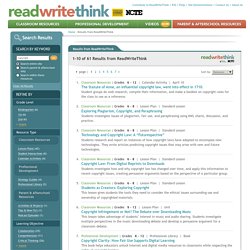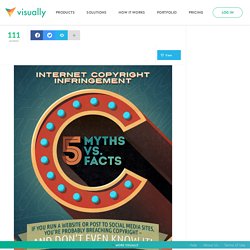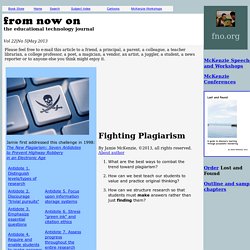

Results on ReadWriteThink. Find content from Thinkfinity Partners using a visual bookmarking and sharing tool.

More Your students can save their work with Student Interactives. More Home › Results from ReadWriteThink 1-10 of 61 Results from ReadWriteThink Sort by: Classroom Resources | Grades 6 – 12 | Calendar Activity | April 10 The Statute of Anne, an influential copyright law, went into effect in 1710. Page | 1 2 3 4 5 6 7. Plagiarism Policies, Copyright Law- www.pleasedontcheat.com - Home. Cb copyright. Five-Minute Film Festival: Copyright and Fair Use for Educators. I absolutely love it when teachers and students create, remix, and mash up media; it's a fantastic way to encourage deeper learning and media literacy.

But one issue that complicates digital freedom of expression is copyright law. While many would argue that copyright law is outdated and badly in need of an overhaul, it's still critical that adults and kids alike have a basic understanding of what's legal and ethical while playing with other people's intellectual property. Here's a list of videos I collected to help you navigate the murky waters of copyright law in educational settings. Video Playlist: Understanding Copyright and Fair Use Watch the first video below, or watch the whole playlist on YouTube. video Understanding "Fair Use" in a Digital World (06:14) This excellent video by Common Sense Media and Teaching Channel shows students evaluating video remixes during a lesson in fair use.
Copyright Infringement: 5 Myths vs Facts. Embed Code Embeded for hosted site: Click the code to copy <div class='visually_embed'><img class='visually_embed_infographic' src=' alt='Copyright Infringement: 5 Myths vs Facts' /><div class='visually_embed_cycle'><span>by </span><a target='_blank' href=' <br/></div><script type='text/javascript' src=' class='visually_embed_script' id='visually_embed_script_88270'></script><p> From <a href=' Embeded for wordpress.com:

A Copyright-Friendly Toolkit. However fabulous Creative Commons and Public Domain content may be, sometimes you really need to use copyrighted material. Say you plan to comment on popular media or current events. For instance, you may be planning to critique the portrayal of Native Americans in commercial films. You are going to want to “quote” some commercial films like Pocahontas, Lone Ranger, and Dances with Wolves. If you are reviewing a book, you may want to share its cover art. You may use copyrighted content without asking permission if you believe that your use falls under the doctrine known as Fair Use. In general, when you transform original content, repurpose it, and add value to it in your own remix, you may be able to claim the use fair. According to American University’s Center for Media and Social Impact, these two tests or questions help you plan whether to use the copyrighted work of others without asking permission:
Teacher's Guides and Analysis Tool. Fighting Plagiarism. This article will focus on the importance of structuring research projects so they require original thought.

The student will not just find an answer. The student will build an answer. It is a bit like cooking a spaghetti sauce from scratch. The research process is a shopping expedition. The student is looking for great ripe tomatoes, red peppers, onions, mushrooms and spices. To help students understand the concept of creating an idea, it helps to employ several metaphors. If students start to think of ideas like buildings, they will view research differently. Picturing an Idea Formulating an Idea - Clarifying Assignments The teacher reduces the chances of plagiarism by creating research tasks that require the formulation of an idea. Here are several ways to require original thinking as the product of student research: Make a choice — When students have to take a stand, they will be operating at the top of Bloom's Taxonomy — the skill of Evaluation.
Anti-Plagiarism Strategies. Robert Harris Version Date: May 18, 2015 Earlier versions: December 30, 2013; February 28, 2012; December 18, 2010; June 14, 2009; November 17, 2004 The availability of textual material in electronic format has made plagiarism easier than ever.

Copying and pasting of paragraphs or even entire essays now can be performed with just a few mouse clicks. The strategies discussed here can be used to combat what some believe is an increasing amount of plagiarism on research papers and other student writing. By employing these strategies, you can help encourage students to value the assignment and to do their own work. Strategies of Awareness 1. Students are faced with too many choices, so they put off low priorities. 3. In addition to a definition, though, you should discuss with your students the difference between appropriate, referenced use of ideas or quotations and inappropriate use.
Discussing with students why plagiarism is wrong may be helpful also. 4. 5. Strategies of Prevention 1. 2.